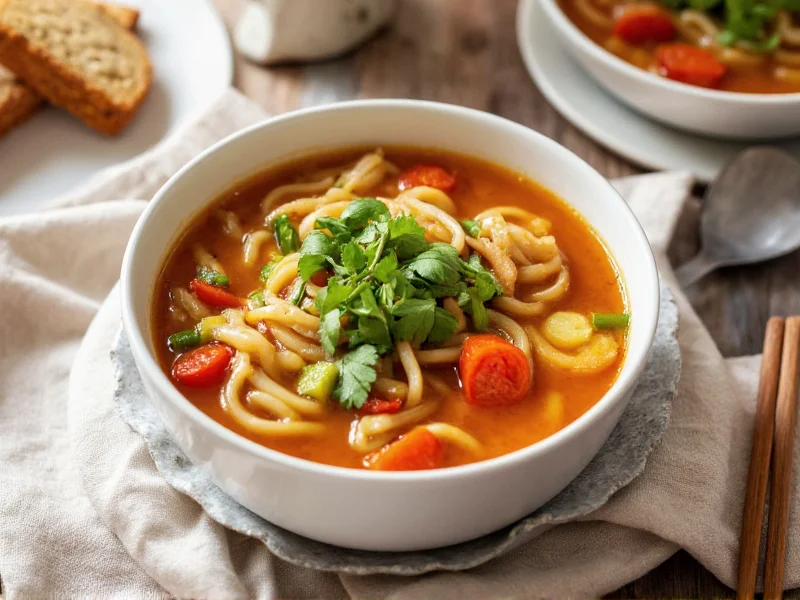Creating exceptional vegetable noodle soup requires understanding the delicate balance between broth depth, vegetable freshness, and noodle texture. This versatile dish serves as both nourishing comfort food and a nutritional powerhouse when prepared correctly. Unlike many canned alternatives, homemade vegetable noodle soup allows complete control over ingredients, sodium levels, and texture—critical factors that transform this simple dish from ordinary to extraordinary.
The Essential Components of Perfect Vegetable Noodle Soup
Professional chefs and home cooks agree that three elements determine vegetable noodle soup quality: broth foundation, vegetable selection, and noodle management. The broth forms the flavor backbone—whether using store-bought or homemade stock, proper seasoning and simmering time extract maximum flavor. Vegetable selection impacts both nutrition and texture, with root vegetables requiring longer cooking than delicate greens. Noodle choice affects mouthfeel significantly, as certain varieties maintain integrity during storage while others quickly become soggy.
Step-by-Step Preparation Guide
Follow this professional method for consistently excellent results:
- Build flavor foundation: Sauté onions, carrots, and celery in olive oil until softened (5-7 minutes)
- Add aromatic elements: Incorporate garlic, thyme, and bay leaves for 1 minute until fragrant
- Pour in quality broth: Use 6 cups low-sodium vegetable or chicken broth, bringing to gentle simmer
- Add hard vegetables first: Include diced potatoes, parsnips, or turnips that need longer cooking
- Introduce noodles properly: Add 1½ cups egg noodles or gluten-free alternative during last 8-10 minutes
- Finish with delicate ingredients: Stir in fresh spinach, peas, or zucchini during final 3 minutes
- Season thoughtfully: Adjust salt, pepper, and acidity with lemon juice or vinegar before serving
Optimal Vegetable Combinations
Different vegetable combinations create distinct flavor profiles and nutritional benefits. Consider these professional pairings:
| Flavor Profile | Recommended Vegetables | Best For |
|---|---|---|
| Classic Comfort | Carrots, celery, onions, peas, green beans | Traditional taste, immune support |
| Mediterranean | Zucchini, tomatoes, bell peppers, olives, spinach | Summer freshness, antioxidant boost |
| Root Vegetable | Potatoes, parsnips, turnips, sweet potatoes | Cold weather, sustained energy |
| Asian-Inspired | Bok choy, shiitake mushrooms, snap peas, ginger | Digestive health, anti-inflammatory |
Advanced Techniques for Superior Results
Professional chefs employ these methods to elevate basic vegetable noodle soup:
- Layered seasoning: Add herbs at different stages—hardy herbs early, delicate herbs at the end
- Noodle preservation: Cook noodles separately and add to individual bowls to prevent sogginess during storage
- Brightness enhancement: Finish with lemon zest or a splash of vinegar to cut through richness
- Umami boost: Incorporate dried mushrooms, tomato paste, or nutritional yeast for depth without meat
- Texture variation: Add fresh herbs or a sprinkle of toasted seeds just before serving
Nutritional Benefits and Dietary Adaptations
Vegetable noodle soup delivers significant health advantages when properly formulated. A standard serving provides approximately 150-200 calories, with 6-8 grams of fiber and substantial vitamin A, C, and K. The broth base contributes hydration and electrolytes, while vegetables supply phytonutrients. For specific dietary needs:
- Gluten-free preparation: Use rice noodles, quinoa pasta, or spiralized vegetables instead of wheat noodles
- Protein enhancement: Add white beans, lentils, or tofu for complete meals
- Low-carb version: Replace noodles with spiralized zucchini or shirataki noodles
- Immune-supportive variation: Include garlic, ginger, and extra mushrooms for additional health benefits
Storage and Reheating Best Practices
Proper storage maintains quality significantly longer. Cool soup completely before refrigerating in airtight containers for up to 4 days. For longer storage, freeze without noodles (add fresh when serving) for up to 3 months. When reheating, add a splash of broth or water to restore proper consistency, as vegetables absorb liquid during storage. Never boil reheated soup vigorously, as this breaks down vegetable texture.
Common Mistakes to Avoid
Even experienced cooks make these vegetable noodle soup errors:
- Overcooking noodles directly in the soup (results in mushy texture)
- Adding all vegetables simultaneously (hard vegetables undercook while soft ones overcook)
- Using excessive salt initially (broth often contains significant sodium)
- Skipping acid component (lemon juice or vinegar balances richness)
- Overcrowding with too many vegetable varieties (creates muddled flavor)
Seasonal Adaptations for Year-Round Enjoyment
Adjust your vegetable noodle soup recipe according to seasonal availability for peak flavor and nutrition. Spring versions shine with asparagus, fresh peas, and baby carrots. Summer soups feature tomatoes, zucchini, and fresh herbs. Autumn variations incorporate squash, sweet potatoes, and hearty greens. Winter preparations rely on root vegetables, cabbage, and kale. Seasonal produce not only tastes better but often costs less and provides optimal nutrient density.











 浙公网安备
33010002000092号
浙公网安备
33010002000092号 浙B2-20120091-4
浙B2-20120091-4